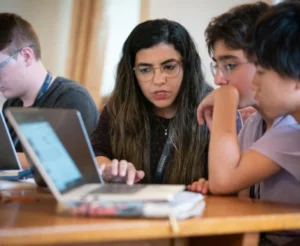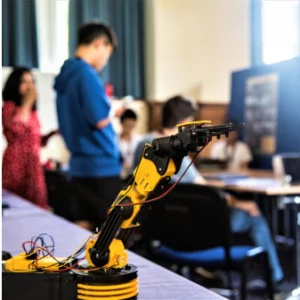The partnership between parents and teachers is one of the most powerful tools to ensure a child’s academic success. While teachers provide critical guidance in the classroom, parents play an equally vital role at home. When home and school connections are strong, students thrive. They feel supported, build confidence, and develop a love for learning.
Understanding the “why” behind these connections is essential. Clear, consistent communication fosters a teacher-parent relationship grounded in trust and shared goals. This ensures that potential challenges don’t go unnoticed while creating an environment where victories, big and small, are celebrated. The importance of parent-teacher communication cannot be overstated, as it forms the basis of a child’s long-term academic and social development.
Here’s how parents can actively build strong home-school connections through effective communication and collaboration.
Home-School Connection Tips
A home school connection isn’t just about exchanging report cards or schedules. It’s about fostering genuine collaboration where parents and educators partner toward a common goal—helping the student succeed. Below are actionable tips to strengthen this bond.
1. Establish Regular Communication Channels
At the foundation of any strong home school communication is consistency. Both parents and teachers should agree on the best ways to share updates on the child’s progress. Whether it’s emails, scheduled calls, or parent portals, finding a parent-teacher communication tool that works for everyone is key.
- Why It Works: Predictable communication builds accountability. Teachers can easily address concerns, while parents can feel informed without constantly seeking updates.
One simple home school connection idea is setting up a weekly email summary covering the week’s highlights.
2. Attend Parent-Teacher Meetings
Parent-teacher conferences are opportunities to discuss more than grades. Use these sessions to understand your child’s learning style, strengths, and areas that may need improvement. Come prepared with questions about classroom dynamics, upcoming goals, and how you can support learning at home.
- Why It Works: These meetings foster a meaningful home school partnership by showing teachers that parents value their input and are engaged in the child’s education.
For families with tight schedules, virtual conference tools now make participation easier than ever.
3. Leverage Technology Wisely
Modern digital platforms allow parents to engage with teachers efficiently. Apps like ClassDojo, Google Classroom, and Remind are excellent tools for teacher-to-parent communication. Through these apps, you can receive notifications about assignments, upcoming events, or behavior notes.
- Why It Works: Technology bridges communication gaps, especially for working parents who may struggle with in-person interactions.
Explore which digital tools your school provides and ensure you’re set up to receive notifications. Clear digital communication reduces misunderstandings.
4. Volunteer in the Classroom or School Events
Participating actively in school activities, whether it’s chaperoning a field trip or running a booth at the school fair, strengthens ties with teachers. Your involvement shows children that their education is a priority and fosters camaraderie between parents and school staff.
- Why It Works: Volunteering bridges the gap between school and home by creating shared experiences.
This home and school connection idea also allows parents to witness the classroom environment firsthand and identify areas where they could lend support.
5. Create a Homework-Friendly Home Environment
Home is the extension of the classroom. Set up dedicated spaces that eliminate distractions, ensuring children have everything they need for effective study sessions. Build a routine where homework and reading times are consistent.
- Why It Works: When a child’s home environment supports learning, the home school partnership strengthens naturally.
If assignments seem overwhelming, collaborate with teachers to understand expectations and how to break down tasks into manageable steps.
6. Acknowledge and Celebrate Achievements
Positive reinforcement creates motivation. Regularly acknowledge your child’s accomplishments, whether it’s scoring high on a test or showing improvement in a specific subject. Share these highlights with teachers—they’ll appreciate seeing their efforts making an impact.
- Why It Works: Success stories improve both the student’s confidence and the teacher-parent relationship.
Consider simple celebrations at home, like a “victory board,” where you display academic milestones.
7. Stay Proactive, Not Reactive
Effective home school communication thrives on proactive involvement. Don’t wait for issues like slipping grades or behavioral concerns to arise. Regularly ask teachers about your child’s progress, especially in areas they find challenging.
- Why It Works: Teachers often appreciate proactive parents who take the time to address potential issues early, making corrective action easier.
For instance, if your child struggles with time management, engaging teachers early can help implement classroom strategies that mirror your efforts at home.
The Importance of Parent-Teacher Communication
Building a strong home-school connection benefits everyone involved. It begins with parents and schools working together to create a collaborative environment that prioritises the student’s interests. Clear communication not only resolves misunderstandings but also prevents them from occurring in the first place.
Here are the key takeaways on why home school collaboration is critical:
It Encourages Consistency in Messages
Children thrive when they hear the same messages reinforced at school and home. If parents and teachers are aligned, students are less likely to feel confused or torn about expectations.
It Provides Early Interventions
Boosting home and school connections ensures that potential issues—academic or behavioral—are caught early. Teachers often see students from unique perspectives, offering insights parents might miss.
- For example, a teacher might notice shifts in focus during particular lessons, hinting at underlying frustrations or struggles.
It Celebrates the Whole Student
Effective communication allows teachers and parents to focus on the child’s growth as a person, not just as a student. Together, these partnerships celebrate the student’s emotional intelligence, resilience, and creativity.
It Reduces Anxiety for Parents
Sending your child to school is a leap of faith. Having a transparent and supportive dialogue keeps parents reassured about their child’s well-being in the classroom. When parents and schools work together, trust forms naturally.
It Models Healthy Relationships
When children see their teachers and parents collaborating and respecting each other, it provides a model for how they, too, should handle relationships in life.
Final Thoughts
A robust home school connection is more than an ideal; it’s a necessity. Every student deserves academic and emotional support, not just at school but also at home. Parents and teachers are allies in this endeavor, steering the child toward success together.
By following the actionable tips outlined in this guide, parents can foster strong partnerships that promote better classroom performance, emotional confidence, and long-term growth. Home and school connections built on mutual respect and proactive communication are truly the foundation of a child’s academic and personal development.
For additional resources, explore our Summer School Enrichment Programs and specialised educational tools. These programs provide opportunities to supplement classroom learning effectively, reinforcing the partnership between home and school. Start building these connections today and watch your child flourish!
Join the Immerse Education 2025 Essay Competition
Follow the instructions to write and submit your best essay for a chance to be awarded a 100% scholarship.



























